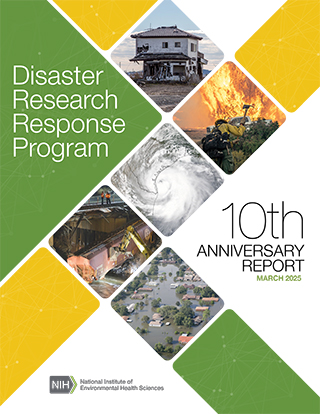By Laura Kiesel

The end of 2024 marked the 10-year anniversary of the National Institutes of Health (NIH) Disaster Research Response Program (DR2), an effort that supports critical research to understand the immediate and long-term human health effects of disaster events. To commemorate the occasion, the DR2 Program released a comprehensive 10th Anniversary Report (7MB) highlighting its milestones.
Disasters and public health emergencies can have catastrophic impacts on the health and safety of individuals and communities around the world. For example, in addition to wreaking visible physical damage, hurricanes and typhoons can flood industrial sites, releasing hazardous chemicals into the surrounding waterways, soil, and air. Earthquakes and wildfires can destroy public infrastructure, such as hospitals and schools, putting the health and well-being of affected communities at high risk.
For the past decade, the NIH DR2 Program, led by the National Institute of Environmental Health Sciences (NIEHS), has been building the expertise and resources necessary to support multidisciplinary public health research efforts and data collection following disaster events and public health emergencies. Without this robust community of practice and infrastructure, valuable data and opportunities to understand the health impacts of these events are lost.
The NIH DR2 Program’s 10th Anniversary Report describes the program’s evolution over the past decade, focusing on successful efforts to improve capacity to address health effects of disasters and public health emergencies. Whether it is in response to a hurricane in Louisiana, an earthquake in Haiti, a train derailment in Ohio, or wildfires in California, the NIH DR2 Program is dedicated to improving global human health by supporting research efforts to enhance preparedness, response, and recovery before, during, and after disaster events.


